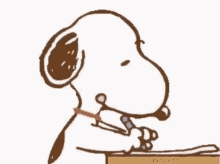In the age of social media apps like Instagram and Pinterest, it's easy to get caught up in the appeal of beautifully designed notes. Everywhere we turn, we see images of neatly organized, color-coded, and artistically decorated notes that are visually appealing and inspire a sense of neatness and creativity.
But this raises an all too important question: Do these aesthetically pleasing notes help you study better, or do they become a distraction and a waste of time? This article will explore the science behind note-taking and review research-backed methods to make your notes effective, efficient, and even pretty.

Photo credit: David Travis from Unsplash
Let us slide into your dms 🥰
Get notified of top trending articles like this one every week! (we won't spam you)The Importance of Note-Taking in General
Note-taking is an essential and critical skill for students and professionals alike. It serves multiple purposes, such as:
- Enhancing comprehension and retention: Writing down information helps reinforce what you learn and makes remembering easier.
- Organizing thoughts: Notes provide a structured way to organize information, making complex topics more digestible in the long run.
- Creating study aids: Well-organized notes can serve as valuable study tools for reviewing and preparing for exams. However, not all note-taking methods are suited for your needs, since some methods may focus on different types of studying and subjects.

Photo credits: Felipe Furtado from Unsplash

Take the Quiz: Music or no music when studying?
Which helps you study better?
The Trap of Aesthetic Overload
Aesthetically pleasing notes often include intricate doodles, elaborate headings, and extensive use of color and highlighters. While these can make notes visually appealing, they can also be very time-consuming to create. Multiple researches suggest that the effectiveness of note-taking lies not in its visual appeal, but in the “cognitive” processes involved.
Cognitive Load Theory
Cognitive Load Theory (CLT) suggests that our working memory has a limited capacity. When note-taking becomes overly complex due to excessive focus on aesthetics, it can increase something called “cognitive overload”, which reduces the amount of mental energy available for learning and comprehension. In other words, spending too much time trying to make your notes look pretty can distract from the actual learning process and impact the amount of information you can take in.

Photo credits: Sarah Elizabeth from Unsplash
Effective Note-Taking Methods
Several studies have examined the impact of different kinds of note-taking methods on learning outcomes and here are some key findings and some example methods to try out yourself:
- Writing vs. Typing: A study by Mueller and Oppenheimer (2014) found that students who chose to take notes by hand performed better on questions and quizzes than students who decided to type their notes. Writing by hand forces students to process and paraphrase information, leading to deeper understanding and better retention.
- Cornell Note-Taking System: Developed by Dr. Walter Pauk at Cornell University, this method divides the paper into three different sections: a narrow left column for so-called cues, a larger right column for general notes, and a summary section at the very bottom. Various studies have shown that this structured approach helps students organize and review information more effectively and a lot quicker.
- Outline Method: The outline method involves organizing notes hierarchically, using headings and subheadings to structure the given information. This method can help students identify main ideas and supporting details, thus making comprehension and recall easier. The outlining method is arguably the most frequently utilized approach to note-taking among college students. The act of outlining provides a comprehensive overview of your current class subject or textbook chapter since it helps structure information systematically and logically. It therefore serves as an effective study guide when you are preparing for an exam or quiz.
- Mapping Method: Mind mapping involves creating a visual representation of information, with a central idea that branches out into related subtopics. Those topics can be structured and arranged by organizing them into different main categories and subcategories that are connected by lines and distinguished with different colors. This makes it easier to recognize connections between the main and subtopics. Research has shown that this method can improve comprehension and memory by visually organizing information to mirror how the brain processes and stores information.

Photo credits: Startaê Team from Unsplash
Combining Aesthetics and Effectiveness
While the primary goal of note-taking should be to enhance learning and memorizing content, there is no reason why notes cannot be both functional and aesthetically pleasing. Here are some tips to achieve a balance, that makes sure your notes can be both pretty and effective:
- Use Color Strategically: Colours can be used to highlight key points, differentiate between different topics, and make notes more visually engaging. However, it is important to use them sparingly to avoid overwhelming your senses and increasing cognitive load.
- Include Diagrams and Visuals: Visual aids such as diagrams, charts, and pictures regarding your subject or topic can make complex information easier to understand and remember afterward. However, these elements should complement and involve your notes rather than serve as mere decoration on the side.
- Adopt a Consistent Format: Consistency in note-taking can help create a sense of order and make it easier to review information. You can use consistent headings, bullet points, and numbering systems to organize your notes to your liking.
- Focus on Content First: It’s also important to remember when taking notes, you should prioritize capturing and understanding the information first and decorate your notes aesthetically afterward since you can always go back and add aesthetic elements later if you have the time, once you secure that your notes are effective and structured.

Photo credits: Greg Rosenke from Unsplash
Note-taking and Personal Preference
It's important to recognize and remember that note-taking is a highly personal activity, and what works for one person may not work for another. Some students may find that incorporating artistic elements into their notes helps them stay engaged and motivated. However, a minimalist approach may be more effective for others, so they don’t get overly distracted during studying. The key is to find a method that aligns with your learning style and enhances your understanding of the material, rather than bothering you during your study sessions.
Conclusion
In conclusion, while aesthetically pleasing notes can be enjoyable to create and especially to look at, you should not prioritize them over effective learning strategies. The science of note-taking emphasizes the importance of cognitive engagement and structured organization over visual appeal.
By combining different methods, while adding your personal preferences, you can create notes that are both functional and visually appealing, ultimately enhancing your learning experience and helping you study more effectively. So, the next time you sit down to take notes, remember that a clear structure and comprehension are the ultimate goals, and a touch of creativity can be the very much-needed cherry on top.









%202%20(3).jpg)



%202-min%20(1).jpg)